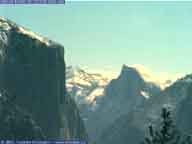
In the Valley
I arrived in the Valley around 4 pm. The contrast to San Francisco was shocking: it was sunny, warm, dry. I drove to the base of El Cap. DAMN! There were climbers on El Cap! My El Cap! The route that was supposed to be "too wet"!

Sure, there was snow on the top of all the mountains, but not the rim of the Valley, and the face of El Cap was apparently dry (there may have been a few dribbles).
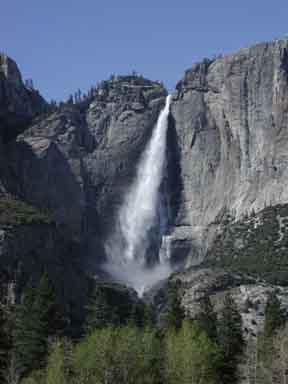
|
All of the named waterfalls were in full throat, especially Yosemite Falls, which thundered all the way out to the road. Unnamed falls and cascades that I had never seen before were sprouted over every cliff face...
...but the fact that there were no less than four parties
on The Nose told me that it was climbable! |
Ring ring ring (...pause...) ring ring ring (...pause...) ring ring ring (beep, beep, buzzzzzz...beep) "we're not home now, please leave a message" (beep)
Beep beep, my assets!!! I wanted to climb! But you can't argue with an answering machine, so leaving my cell number, I had to content myself with laying in the grass of El Cap Meadow, leaning against a log, eating some of my Mountain Mush, and watching someone try the King Swing through my binoculars. The climbers were not making much progress, but I knew all the pitches, all the formations. It was like I was in their vest pocket, watching everything they were doing, knowing what they were facing.
The sun left the Valley, hiding behind the mountains off to my left around 7:30 pm, and with the sun went the warmth. It got very cold in the space of a few minutes, so I walked back to my car, with visions of climbing swirling in my head. I was excited, not scared.
I drove to Curry Village, checked in, got my key and tent assignment, 705. Ken called, and I made my case for climbing: dry rock, parties on route, nice weather, anything I could think of. Ken was a bit taken aback As he had warned me in his email of May 8, " I am not going to get everything together until we have a plan." All of his gear was still stored away, he wasn't ready! However, Ken is truly a great guide and a great human being. (He gave me a hint of it here, but I would learn more of this side of him as we climbed.) He knew how excited I was, how much it meant to me, so he allowed that he would rummage through his gear and meet me at 8:30 am at the Mountain Shop. Gosh, now I was stoked! El Cap in the am! Right on!
Then I realized that I had not brought my gear for El Cap.
![]()
It was safe in San Francisco. I knew we weren't going to do the Real Climb, it was too wet. Just some low-down climbs. So I brought only enough to do short stuff! No spare batteries for the camera (two sets of four each)! No disposable camera (two) for backup. No dried fruit, no quarts and quarts of Mountain Mush, spam, sardines, candy bars, no stuff sacks, no....no......no........................no.................................................................................................................................
![]()
Hell! Climbing food is available in the Yosemite Village store (where do you think all the wall rats get theirs? San Francisco?), batteries in the deli next to the Mountaineering store, etc. Scew it! I was going to do El Cap!
I put my food into my assigned bear box (due to the fact that bears are in the Valley, all food must be stored in bear boxes). My assigned bear box, related to my tent number, was just outside the pool and shower complex. I went for dinner to the Curry Cafeteria (scene of many a perloined meal from a tourist by indigent climbers), ate, and thought. Boy, things sure had changed in the last few hours! Gone was the worry about how to arrange things so I could climb during my backup time, gone was the worry about the rain, gone was the disappointment about not getting to climb the Big Stone. Now I had to think about shifting gears and getting ready. "Prologue" was going to shift into "Epic Tale", if only I was man enough.
![]()
Tuesday, May 13, 8:30 am, I meet Ken at the Mountain Shop, the home of the Yosemite Mountaineering School. Something was wrong. His face, his manner, his words told me I was in for a big disappointment: "Dave, could you step outside a moment? We have to talk."
![]()
We walked a dozen steps (is that the length from the holding cell to the electric chair?) and sat on a table (at times like this you don't sit on a chair, you sit on the table). "Dave, I don't think we can go today..."
![]()
"I don't think we can fix to Sickle today." We had planned to climb up four pitches to Sickle Ledge, leave fixed ropes in place, rappel down, get a last good night's rest, then jumar up the ropes the next morning. This is a standard approach to The Nose. "I think that we need all day today to get ready. We will pack today, then blast off tomorrow. OK?"
So it wasn't what I thought. No problemo! I had told Ken that although I used to teach climbing and had led a Grade V bigwall, I was smart enough to know that I didn't know. As much as he did, what had changed in the last 25 years, what we should be doing. He was going to be the leader in this, a Grade VI. Climbs of this rank are no piddling matter. I told him that I would not argue issues with him. (If any of you reading this are surprised, well, you just found out that you didn't know me as well as you thought. I like to lead, but I am smart enough to know when to follow.) We did not need two chiefs and no Indians in this outfit. As far as I was concerned, if he wanted to wait until Groundhog Day, fine by me. Next morning was even better than Groundhog Day, of course, but who was I to argue that we should go today? No problemo!
He had warned me in his email that he was not going to get his gear ready until we had a plan, and overnight was not enough lead time to change the plan and get his gear out. It has been stored all winter in a shed and would take some time sorting.
![]()
We went right to it. Ken needed some new equipment, some of his had rather had a hard time at the end of last year. One thing he wanted was a new haulbag. He had one good one but needed a second. He picked one out at the shop, plus some minor things. As a favor to him, I paid for it. I had been planning getting him some gear anyway, and this opportunity was perfect.
![]()
We walked out to the parking lot, to where he always (illegally, <snigger>) parks his truck. We drove out to El Cap Meadow to rack and pack. "To rack" means to select the technical rock climbing gear, such as cams and nuts and carabiners, that you are going to need for a climb and to place it on your harness or gear sling. We also selected ropes (two kinds: one for leading or belaying; this kind is stretchy, to soften the force of a fall; and one for hauling the haulbag, which is not stretchy, so that when you haul up ten feet of rope, the pig [affectionate nickname for the haulbag; haul one and you will understand] actually moves up ten feet), slings, water bottles, etc. As we select a piece of gear, it goes into one of the two haulbags. (These will get packed and unpacked about five more times.)
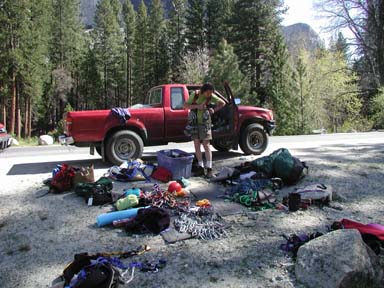 |
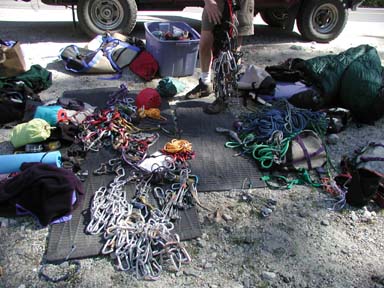 |
A kind of song and dance is going on all this time. Not only are we in El Cap Meadow, racking and packing, but so are a whole bunch of other rock rats. Racking and packing. For their Grade VI.
We each kind of walk along, sidle up to another group, coyly ask how things are going ("I'm packing madly trying to get on the route before you do!" is what they are thinking, but the answer is "Oh, we thought we might go up to (Name of Route) and check it out..."), what they are planning to do (it is rather obvious that it is rock climbing! "What does it look like we are doing? Forming a sewing circle?" is everyone's thoughts), where they are headed (ie, get on "my" route?). It is very pleasant, but not unlike a bunch of shy high school boys at their first dance or a fly fisherman who is getting skunked while another fisherman nearby is hauling 'em in. It is kind of a riot. Apparently this dance has been going on for a long time. They all seem to enjoy it, but at the same time, it is very serious: if two other groups get onto a route before you do, you might be twiddling your thumbs for a day or two, while other hungry vultures swirl around your shoulders, trying to get on before you do. Serious business. We all have been planning for ages, have tight schedules, are under the tension of doubt about our ability to complete the route, etc.
We also sorted water bottles. Water is critical on a climb: too little and you suffer like hell. Too much and the pig will kill you with hauling all that weight. The way you carry water is in two-liter soda bottles. There are stronger bottles, but a stronger bottle is harder to crush. The two-liter soda pop bottle is perfect. It is strong enough that you won’t be able to rupture them, but they are weak enough that when you are done, you can crush them so you don’t have a huge volume, and put them in the bottom of your pack. If you take a gallon per man day (we were planning for cold weather and five days, with water for six; if the weather turns hot, two gallons a day is often inadequate), that is twelve gallons. A gallon weighs eight pounds, so twelve times eight is a hundred pounds of water and we carried a bit more than that. We figured about one hundred and thirty pounds of water.
Ken had gotten the bottles the honest and the traditional way: dumpster diving (he got them out of the trash). We counted out empty bottles. Then counted them again. My job was to take a loop of very thin nylon climbing rope and girth hitch it to the neck of the bottle, securing it with duct tape. As I said, water is serious on a climb, and you don’t want to lose it. First of all, if you drop it, you lose your water and you may be in big trouble. I ran out of water 25 years ago on Washington's Column, when the weather hit 105 degrees in the Central Valley. Didn't drop any, just did not take enough for the hot weather. Most painful experience I have ever had, and the pain went on for two days. Imagine doing heavy labor on the sidewalk in 105 degree sun. Now imagine it with no water. Never again. The second reason you don't want to drop it is that it is heavy and you could really hurt somebody; if you drop it a thousand feet and hit somebody on the head, they are dead. So, it was my job to put a gear loop on each bottle with a girth hitch and then duct tape it in place.
We also sort our personal gear. You have to be ready for heat, cold, rain, and wind. Not "or". The operative word here is "and". People have died of hypothermia in the summer, from wearing cotton clothing and no raingear. John Dill, a director of the Yosemite Search and Rescue (YOSAR) team and historian of rescues in the Valley, has written: "On October 11, 1983, a climber on El Cap collapsed from heat exhaustion. On October 11, 1984, a party on Washington Column was immobilized by hypothermia. You can expect this range of weather year round." (For his full essay, click here, then click on "Climbing Saftey." It is great reading.)
I packed some Mountain Hardware thick poly long underwear, uppers
and lowers; waterproof pants and parka with a hood that will fit over a helmet;
wool hat, baseball cap (for the visor, keeps sun out of your eyes as you stare
for hours at your partner, barely moving on a tough pitch that is directly into
the sun; been there), camera (both digital and a disposable, plus extra batteries),
poly vest, poly Patagonia jacket. I am wearing wool pants that I had bought
at the Salvation Army and on which I had sewed knee patches and a butt patch.
We get all the gear in the haul bags, throw them in the back of his truck, and take off for Yosemite Village. We buy sandwiches at the Deli (I buy, what else? an El Cap: ham and cheese, piled high, a mountain of a sandwich) and have lunch.
Then it is off to the Mountain Shop, where next to it is an employee's laundry room. Ken shows me how to clean and fill the bottles. He wants to go to the Mountain Shop, as the Patagonia rep is there and he can buy all the stuff he wants at a big discount. I tell him to go, don't worry about me. I may not be the "chief cook and bottle washer", but I can certainly be just the "bottle washer". Actually, I enjoyed shade, quiet, and routine of cleaning, filling, then duct taping all 24 water bottles. "Get the root beer ones really clean," Ken advised. "The orange ones kind of taste good if the flavor lingers, but the root beer ones are terrible." I make the independent decision that they all need to be clean enough to not have any residue from whoever drank from them last, root beer or orange, and clean the heck out of them. The lids are then taped in place, so they don't come loose during the hauling. You want to avoid the scenario of, "Say, where do you think that wet spot is coming from in the bottom of the haul bag?" You don't want to hear that.because any time you have a leak you have a problem.
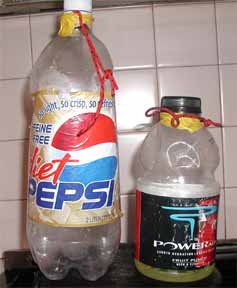
Next we head to Yosemite Village and buy our food. Even with Ken's 20% discount, we spend $122 for just six days. Bagels (two bags), jerky, Jolly Ranchers, string cheese, and six cans of cashews are Ken's favorites, and we load up on those. I get some tortillas, spam, sardines, fig newtons, apples. Ken was not sure (read "against") my choices but went along with it, since I wanted it. (We ate all of Ken's stuff, never touched mine. Ken was right.) We buy six liters of PowerAide, Ken's favorite on the wall. It is a kind of Gatoraide, electrolyte replacement drink. They actually taste great, and make a good midnight pee bottle. (We tried not to mix them up...)
![]()
We drive back to El Cap Meadow, to unpack and repack, now with the food and water. As we drive, he asks me, "How are your knees?" I found out later what this meant. We arrive in the meadow and unloaded the truck.
By now we had been out in the meadow once for a couple of hours and I had forgotten to put sunburn lotion on because it is coldish and whatever. I could already feel my face was burned. That really bothered me. You don’t want to start a climb with burned skin. So I sat in the shade as we packed our bags.
Here I am, beside Ken's truck, with one of the the haul bags in the foreground. We got them packed. A bit heavy, though.
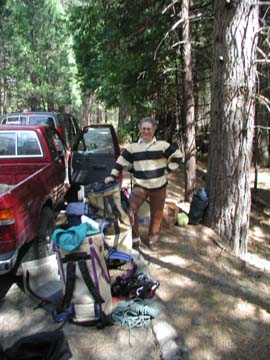
I cannot lift mine, and although Ken can lift his, he can barely walk. (Remember, we have to carry these up the scree slopes to the base of the climb.) Ken helps me put mine on, about 120 lbs, but I can barely stand. Ken declares that he can carry his in one trip, but he will break mine down into two. (Then I figured out, "How are your knees?" actually means, "How strong is your back?" Sometimes you just have to learn to speak "climbing".)
We walk out into the meadow with my Leica binocs and study the route and the climbers who are on it. There are four parties on the route, two low down on Sickle, one above the Great Roof, and one at Camp IV. (You can see these on the topo map.) Ken is worried about crowds. Too many above, you get rockfall and can't get past 'em. Too many below and they are crowding you at the belays, pushing you to go faster than you want to go.
We continue to do the "How are things with you, where you goin'" dance. There are no other parties going on The Nose tonight or in the am, but two are planning to fix to Sickle tomorrow afternoon, to blast off in two days. After puzzling and puzzling til our puzzlers were sore, we decided to pack it in, eat our respective dinners (Ken's wife wanted him to cook dinner; she is pregnant with their third), so we agree to meet at 5:30. The moment of truth was approaching.
I want off to Curry Village. I actually felt very calm and peaceful. Going to the cafeteria, I brought my copies of the SuperTopos, Roper's Camp 4 book, and my diary, and had dinner. I re-read, for the ump-teenth time, the section about the first climbing of El Cap by Warren Harding and his comrades.
I tried to write a little, of my feelings. My diary reads, "The weather has finally cleared and tomorrow is the day I have been waiting for so long. 11 months in the making. 5:30 tomorrow...What am I feeling? El Cap certainly represents the biggest, most demanding, most exacting adventure I have ever done. Excited. Nervous. At Peace. Not really worried or anxious. At Peace, enjoying all the little things of preparation: washing the water bottles, filling and testing them, taping the tops and the tie-ins; seeing old people and babies each enjoying their perspective of what Yosemite is, as I get ready to experience mine."
I arranged to check out of Curry at 4: 30 am the next morning, bought a lock and keys to place my violin, binoculars, and extra food into a bear container next to the parking lot (these are for the use of climbers, backpackers, etc, who are not staying in Curry; the tent bear boxes are just for while you are staying there), bought an alarm clock, and moved all the stuff out of my tent that I did not need that night, so as to make the morning's work shorter. I went off into the parking lot with my violin (so as not to disturb anyone; you would understand if you knew how awful my playing is) and played for about an hour. It was beatifully still and cool. An expectant night. Then I set the alarm clock to 4:30 and went to bed.
I fell asleep quickly. The moment of truth was approaching.
Next: Day One